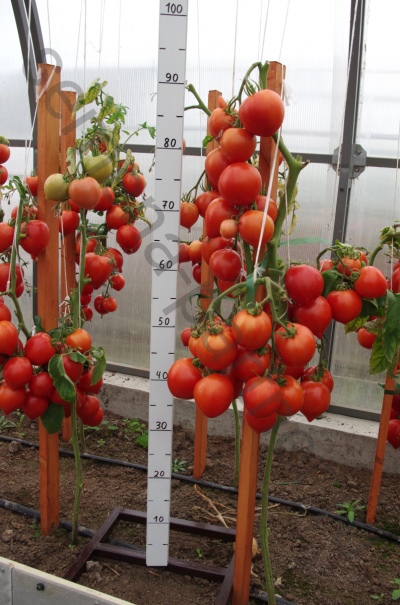
- Authors: Kiramov O.D.
- Year of approval: 2017
- Category: hybrid
- Growth type: determinant
- Appointment: fresh consumption, for pickling and preserving
- Ripening period: early
- Ripening time, days: 85-90
- Growing conditions: for open ground, for film greenhouses
- Marketability: high
- Bush height, cm: 60-70
Newer varieties of tomatoes can be just as effective aids for gardeners as well-proven varieties. However, each such plant must be studied as deeply as possible. The Diadem variety also deserves special attention.
Breeding history
The Diadem Tomato was created in 2017. The main selection work was carried out by a large modern breeder OD Kiramov. Strictly speaking, this is not a pure variety, but a hybrid.
Description of the variety
The diadem is characterized by the determinant development of the bushes. Its fruits are highly marketable. The culture is suitable both for an open garden and for a greenhouse under a film. The bushes are low - almost always limited to a height of 0.6-0.7 m. Moderately long leaves have a simple green color.
The main qualities of the fruit
Unripe Tiara berries are light green in color. When they are ripe, they will take on the typical red tone of many tomatoes. The mass of tomatoes will be 200-220 g. The berries are round, ribbing is not too pronounced. 5 or 6 tomatoes are formed on 1 brush from a simple inflorescence. They need to be removed when you reach technical maturity.
Taste characteristics
The flesh of the Diadem is moderately firm.
Ripening and fruiting
Diadem is a classic early tomato. Its fruits will ripen in 85-90 days after pecking of green shoots. After this point, fruiting will take a long time. This circumstance will definitely please any summer resident.
Yield
The declared ability to achieve a yield of 18 kg per 1 m2. But this can only be achieved with strict adherence to agrotechnical standards. Regular watering and careful fertilization are the minimum requirements.
The timing of planting seedlings and planting in the ground
It is necessary to place seeds in boxes or containers 50-55 days before the expected time of transplanting into open ground. This term should be applied flexibly, taking into account the specifics of a particular region. The seedlings will have to dive after the appearance of 2 true leaves.

Growing tomato seedlings is an extremely important process, because it largely depends on whether the gardener will be able to harvest at all. All aspects must be taken into account, from seedbed preparation to planting in the ground.
Landing scheme
There is no point in inventing anything original in this respect. You just need to adhere to the established order - 4 bushes per 1 "square". In the process of formation, 2 or 3 main stems are left. Closer cultivation threatens with a number of additional problems. Some sources write that in greenhouses and sheltered places it is necessary to plant tomatoes according to the 800x500 mm system, and on the beds - 700x400 mm.

Growing and care
Watering is impractical within 5-7 days after planting the seedlings.Breaking this rule is allowed only in hot dry weather. The trellis cultivation method is encouraged, especially with sufficient illumination. Seed material cannot be extracted from the fruit, since it is a hybrid. In order for the seedlings to survive the planting well, it is recommended to harden them in advance.
Watering is recommended to be done relatively rarely. However, each of them must be abundant. In cloudy weather, the Diadem is watered even less often. Mulching with hay, wood chips or peat can alleviate water shortages. The first feeding is applied 18-20 days after planting.
The next fertilization is done 14 days after the first time. In addition to mullein, potash and phosphorus mixtures are used. When another 2 weeks have passed, you need to apply a nitrophosphate.




A plant needs different micronutrients at each stage of growth. All fertilizers can be divided into two groups: mineral and organic. Folk remedies are often used: iodine, yeast, bird droppings, eggshells.
It is important to observe the rate and period of feeding. This also applies to folk remedies and organic fertilizers.
Disease and pest resistance
The variety has no specific pests for itself. And also it can perfectly resist infection:
alternaria;
bacterial infections;
fusarium wilting;
tobacco mosaic;
top rot of the fruit.
But we must understand that pathogens are looking for - and still finding - ways for infection. Therefore, preventive treatments will be strictly required. They should be carried out taking into account the growing season and according to the instructions of the chemical manufacturers.


Growing regions
The plant is zoned into:
Central Black Earth Region;
all regions of the Volga region and the Urals;
West Siberian, East Siberian and Far Eastern regions of Russia;
territories and republics of the North Caucasus;
regions of the north, center and northwest of the European part of Russia.

























































































